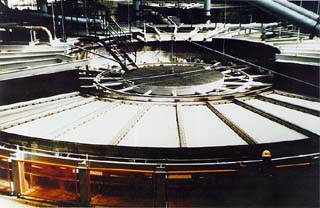
| Click
on the thumbnail to maximize the image |
The Tilting Pan Filter belongs to the top feed group and has found its main application in the phosphoric acid industry and, to some extent, in the washing of phosphate rock. As already mentioned in the Horizontal Belt Filters section there was a traditional rivalry over the years between the Pan and Belt Filter which now, owing to the substantial progress in rubber technology, swings in the favor of the later.
 |
|
|
At the last stage before relevelling, suction is applied to evacuate the wash water that accumulates inside the pan, and at the same time it dries the cloth to avoid dilution of the mother filtrate. Since during this stage air passes freely through the exposed cloth, applying suction with the main vacuum pump will cause a loss of vacuum to the entire system, hence, an auxiliary small vacuum pump is incorporated to separate between the vacuum zones. |
|
The main valve, that is also called distributor, controls the cycle segments with bridges that open and close the port of each pan as it passes from high vacuum through cake blow-off to low vacuum. Compartments within the valve separate the various zones to ensure that the separation is sharp and no mixing of mother, strong, middle and weak filtrates occurs during the cycle.
|
To speed up the evacuation of the various filtrates there are valves with two bridge circles, one for the main stream and the another that opens to atmosphere and purges the pan below the deck just before entering a new zone.
The speed of rotation determines the cycle time and this, being an important design parameter, is limited mechanically by the mass inertia of the swinging pan and its wet cake load at the point of discharge. Typical cycle times for Pan Filters are 2½ to 3 minutes depending on the size of the filter and the design of the peripheral cam that controls the tilting velocity.
Pan Filters are available for dry or wet cake discharge depending on the method of disposal. The discharge zone for dry discharge consists of two chutes, one for the dry cake and the second for cloth washing. The zone for wet discharge has one chute only in which the cake is sluiced and then the cloth is washed. Dry cake discharge consumes about 3-4% more effective filtration area than the wet discharge so this should be taken in account while calculating the required area.
The Tilting Pan Filter is constructed from the following subassemblies:
As mentioned in an earlier discussion the Pan Filters have
been set aside once the rubber technology enabled the manufacture
Horizontal Belt Filters with large filtration
areas. Presently there are no outstanding features to prefer a Tilting Pan
Filter over a Belt Filter although many of them are in extensive use.
The cycle of a Tilting Pan Filter that includes three counter-current washing stages consists of the following zones:
The major parts requiring inspection for preventive maintenance are:
The pans for corrosion even if fabricated from UB6, Sanicaro 28 or 914L for the harsh phosphoric acid conditions.
The wear plate of the main valve for erosion since its large diameter makes it vulnerable to loss of vacuum.
The twisting rubber hoses or "O" ringed elbows which connect the rotating pan necks with its pipe and wear plate to the face of the stationary valve.
The condition of the high impact nozzles mounted on the cloth wash manifold and, for wet cake discharge, the sluicing manifold.
The support rollers which take the vertical load of of the entire machine and the horizontal thrust rolls that keep the rotating frame concentric.
The toothed rim and sprocket which drives the Pan Filter.